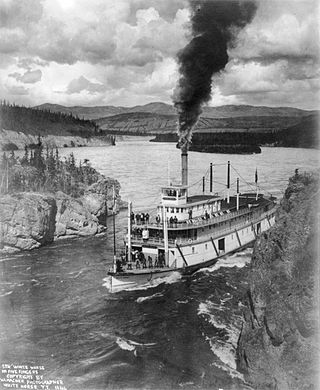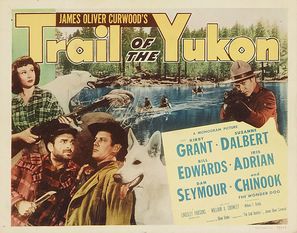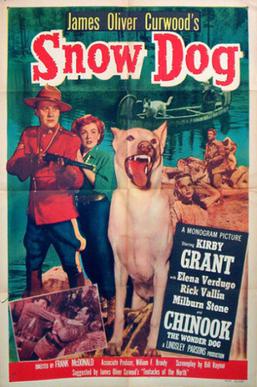
Nome is a city in the Nome Census Area in the Unorganized Borough of the US state of Alaska. The city is located on the southern Seward Peninsula coast on Norton Sound of the Bering Sea. It had a population of 3,699 recorded in the 2020 census, up from 3,598 in 2010. Nome was incorporated on April 9, 1901. It was once the most-populous city in Alaska. Nome lies within the region of the Bering Straits Native Corporation, which is headquartered in Nome.

The Municipality and Borough of Skagway is a first-class borough in Alaska on the Alaska Panhandle. As of the 2020 census, the population was 1,240, up from 968 in 2010. The population doubles in the summer tourist season in order to deal with the large number of summer tourists each year. Incorporated as a borough on June 25, 2007, it was previously a city in the Skagway-Yakutat-Angoon Census Area. The most populated community is the census-designated place of Skagway.

The Klondike Gold Rush was a migration by an estimated 100,000 prospectors to the Klondike region of Yukon in northwestern Canada, between 1896 and 1899. Gold was discovered there by local miners on August 16, 1896; when news reached Seattle and San Francisco the following year, it triggered a stampede of prospectors. Some became wealthy, but the majority went in vain. It has been immortalized in films, literature, and photographs.

The Call of the Wild is a short adventure novel by Jack London, published in 1903 and set in Yukon, Canada, during the 1890s Klondike Gold Rush, when strong sled dogs were in high demand. The central character of the novel is a dog named Buck. The story opens at a ranch in Santa Clara Valley, California, when Buck is stolen from his home and sold into service as a sled dog in Alaska. He becomes progressively more primitive and wild in the harsh environment, where he is forced to fight to survive and dominate other dogs. By the end, he sheds the veneer of civilization, and relies on primordial instinct and learned experience to emerge as a leader in the wild.

White Fang is a novel by American author Jack London (1876–1916) about a wild wolfdog's journey to domestication in Yukon Territory and the Northwest Territories during the 1890s Klondike Gold Rush. First serialized in Outing magazine between May and October 1906, it was published in book form in October 1906. It is a companion novel to London's best-known work, The Call of the Wild (1903), which is about a kidnapped, domesticated dog embracing his wild ancestry to survive and thrive in the wild.

Chilkoot Pass is a high mountain pass through the Boundary Ranges of the Coast Mountains in the U.S. state of Alaska and British Columbia, Canada. It is the highest point along the Chilkoot Trail that leads from Dyea, Alaska to Bennett Lake, British Columbia. The Chilkoot Trail was long a route used by the Tlingit for trade.

White Fang is a 1991 American northern period adventure drama film directed by Randal Kleiser, and starring Ethan Hawke, Klaus Maria Brandauer, and Seymour Cassel. Based on Jack London's novel of the same name, the film tells the story of the friendship between a young Klondike gold prospector and a wolfdog. White Fang is portrayed by a wolfdog, Jed, who also appeared in such films as The Thing (1982) and The Journey of Natty Gann (1985). The film was released on January 18, 1991, by Buena Vista Pictures. A sequel to the film, White Fang 2: Myth of the White Wolf, was released in 1994.

Rex Ellingwood Beach was an American novelist, playwright, and Olympic water polo player.

The Northern or Northwestern is a genre in various arts that tell stories set primarily in the late 19th or early 20th century in the north of North America, primarily in western Canada but also in Alaska. It is similar to the Western genre, but many elements are different, as appropriate to its setting. It is common for the central character to be a Mountie instead of a cowboy or sheriff. Other common characters include fur trappers and traders, lumberjacks, prospectors, First Nations people, outlaws, settlers, and townsfolk.

Steamboats on the Yukon River played a role in the development of Alaska and Yukon. Access to the interior of Alaska and Yukon was hindered by large mountains and distance, but the wide Yukon River provided a feasible route. The first steamers on the lower Yukon River were work boats for the Collins Overland Telegraph in 1866 or 1867, with a small steamer called Wilder. The mouth of the Yukon River is far to the west at St. Michael and a journey from Seattle or San Francisco covered some 4,000 miles (6,400 km).

The Nome Gold Rush was a gold rush in Nome, Alaska, approximately 1899–1909. It is separated from other gold rushes by the ease with which gold could be obtained. Much of the gold was lying in the beach sand of the landing place and could be recovered without any need for a claim. Nome was a sea port without a harbor, and the biggest town in Alaska.
The Klondike Gold Rush is commemorated through film, literature, historical parks etc.
Frank BurgessMcDonald was an American film and television director, active from 1935 to 1966. He directed more than 100 films, including many Westerns starring Gene Autry and Roy Rogers, and numerous TV show episodes. He is interred at Conejo Mountain Memorial Park in Camarillo, California.

Trail of the Yukon is a 1949 American Northern film directed by William Beaudine and starring Kirby Grant, Suzanne Dalbert and Bill Edwards. It was based on a novel by James Oliver Curwood about a North-West Mounted Police officer and his faithful German Shepherd dog Chinook. It is part of the Northern genre. The film was popular, and inspired Monogram to make a series of nine further films starring Grant and Chinook.
The Wolf Hunters is a 1949 American Northern film directed by Budd Boetticher and starring Kirby Grant, Jan Clayton and Edward Norris. It was based on the novel of the same title by James Oliver Curwood, which had previously been adapted in 1926 as The Wolf Hunters and in 1934 as The Trail Beyond starring John Wayne, Noah Beery, Sr. and Noah Beery, Jr. The film was the second in a series of ten films featuring Kirby Grant as a Canadian Mountie.

Call of the Klondike is a 1950 American Northern film directed by Frank McDonald and starring Kirby Grant, Anne Gwynne, and Lynne Roberts. The film was the fourth in the series of ten films featuring Kirby Grant as a Canadian Mountie.

Snow Dog is a 1950 American Northern film directed by Frank McDonald and starring Kirby Grant, Elena Verdugo and Rick Vallin. It was the third of a series of ten films featuring Grant as a Canadian Mountie.

Yukon Manhunt is a 1951 American Northern film directed by Frank McDonald and starring Kirby Grant, Gail Davis and Margaret Field. The film was the sixth in the series of ten films featuring Kirby Grant as a Canadian Mountie.














